What's The Difference Between Capicola And Soppressata?
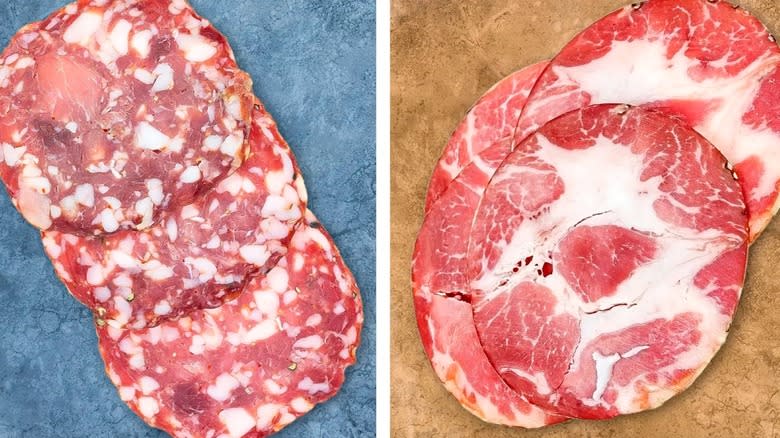
If you've ever dipped your toe in the delicious waters of Italian sandwiches, you may have experienced the delights that are soppressata and capicola -- possibly without even knowing the names of the meats you were eating. Or, if you haven't tried either in a sandwich, perhaps you sampled them on a charcuterie board surrounded by cheese and olives. Unless you're well-versed in Italian deli meats, you may not fully understand the differences between the two, so let's dive in.
Soppressata and capicola have plenty in common. They both come from pigs — albeit different parts — they both contain plenty of fat, and they both feature rich, tasty flavors. There are some sandwiches that include both of these sliced meats, but because of the way they're cut, seasoned, and cured, you wouldn't always use capicola in the same place that you'd deploy soppressata. These meats have different nicknames, backgrounds, tastes, and textures, and it takes a little understanding of each to figure out how to make the most of them.
Read more: The Best Meat For Your Charcuterie Board Isn't One You'd Expect
What Is Capicola?
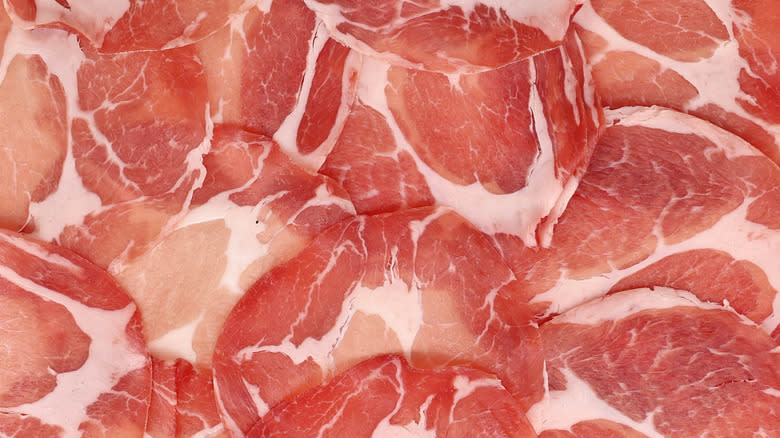
If you've never seen a meat labeled "capicola" before, that doesn't necessarily mean you haven't spotted it. Capicola has a plethora of nicknames, including capocollo, coppa, and -- if you live in New York or New Jersey -- gabagool. While the names may vary, they all mean the same thing: A cured meat that comes from the part of the pig between the head and shoulder. In fact, one of these nicknames comes from these areas, as capo means "head" and collo means "shoulder" in Italian.
While capicola may be a lesser-known cold cut in the U.S., its history goes very far back in Italy -- all the way to the ancient Roman era to be exact. The meat originally comes from Piacenza, a province in the northwest of Italy, as well as Calabria, a southern region on the coast. These two types are the only ones that have received E.U. Protected Designation of Origin (PDO) status, so if you see "Coppa Piacentina" or "Capocollo di Calabria," you know it came from these regions only. However, there also are a few other varieties, including "Capocollo di Lazio" from the center of the country and "Capocollo tipico senese" from Tuscany.
What Is Soppressata?
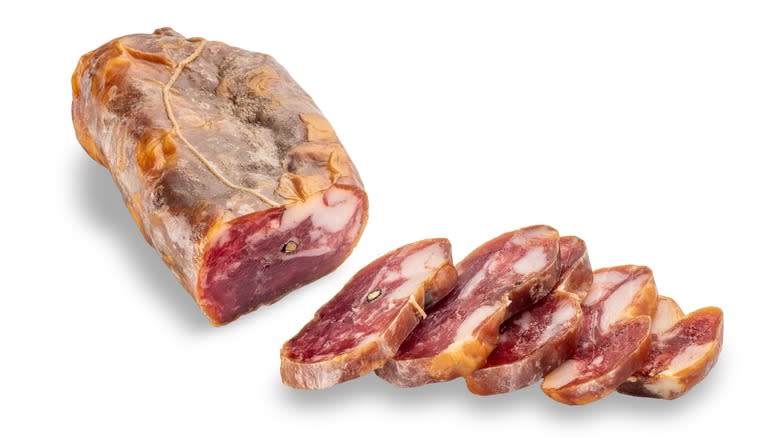
If you're interested in trying soppressata, you'll only have one name to keep track of, but that doesn't mean this Italian meat is boring or even simplistic. The name may come from the Italian word "soppressare," which means "to press." However, the meat does differ from sopressa, which comes from northern Italy and tends to use more spices than soppressata, such as cinnamon and black peppercorn. Unlike capicola, which is a more straightforward cold cut, this version is a sausage that can pack in a few different cuts of meat.
One variety of soppressata is blessed with E.U. Protected Designation of Origin status, and it comes from Calabria as well. There are quite a few requirements for the meat to achieve this honor, including that it has to come from pigs born in Calabria, Sicily, Puglia, or Basilicata. Additionally, the animals must be slaughtered in the former and they can't weigh over 140 kg. While these specifications are in place today, the meat likely originally came from ancient Roman times as well, when peasants would piece together sacrificial pigs to make a sausage.
Capicola Is Often Refrigerated Before It's Dried
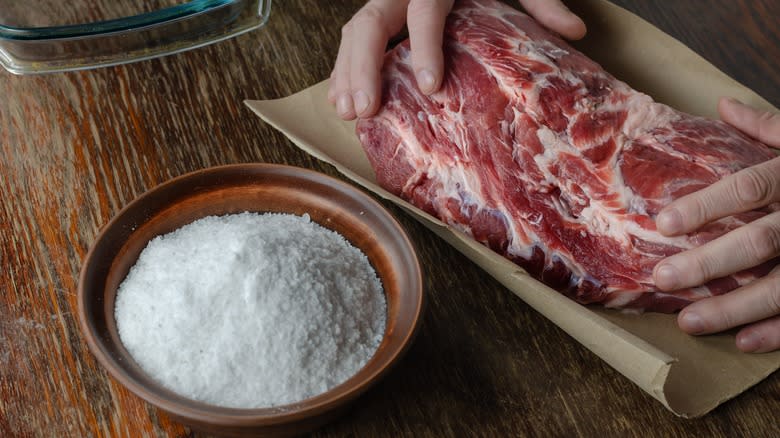
Capicola is made by dry-curing the meat between the head and shoulder of the pig, but before it reaches that step, it's first seasoned with a mixture that can include paprika, salt, garlic, wine, pepper, cloves, fennel, cinnamon, nutmeg, and bay leaves. The exact flavorings can vary depending on the region that the meat is being made in. Before the meat goes into a casing, some methods call for vacuum sealing and refrigerating the pork for multiple weeks, which can help prevent it from drying out.
Once the meat emerges from the fridge, it gets stuffed into casings that are held together with string. You can either go with a natural type, which would be made from animal intestines, or a processed version made from collagen -- both will do the job. The former has been used over the centuries to cure meat, but the latter is an affordable substitution in today's world. Finally, you'll hang the pork for anywhere from seven days to six months, ideally in a curing chamber that has a controlled temperature.
Soppressata Is Pressed To Squeeze Out Excess Water
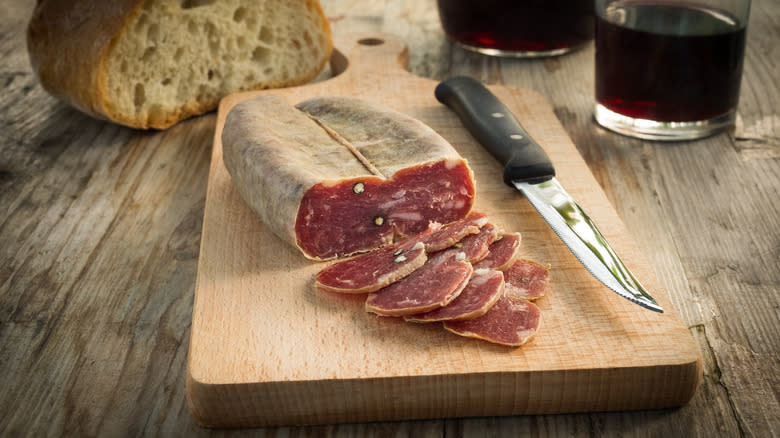
Just like with capicola, the seasonings used to make soppressata can vary widely by region. You may see red wine along with salt, black pepper, garlic, cloves, rosemary, or chile peppers, the latter of which are common in southern Italy to create a spicier sausage. Depending on where you get it from, soppressata can be made with from the shoulder, loin, or assorted pork bits.
If you're buying the Calabrian version that has PDO status, it has to meet a few additional requirements. In this case, only the ham and shoulder can be used, any fat has to come from the loin, and the fat content has to fall in the 12% to 15% range. Plus, the pigs need to be at least eight months old.
Before it's seasoned, the meat is ground along with the fat. Then, it's packed into casings and tied with string, just like capicola, and hung to dry for about two weeks. You may also see a powdery white coating on the outside, which is an edible mold called penicillium that keeps bacteria from entering the meat. Afterward, the soppressata is pressed with a heavyweight for a few days, which squeezes out excess liquid and gives the log a flatter top and bottom. Finally, the meat continues aging for up to three months.
Capicola Is Soft And Sliced Thin
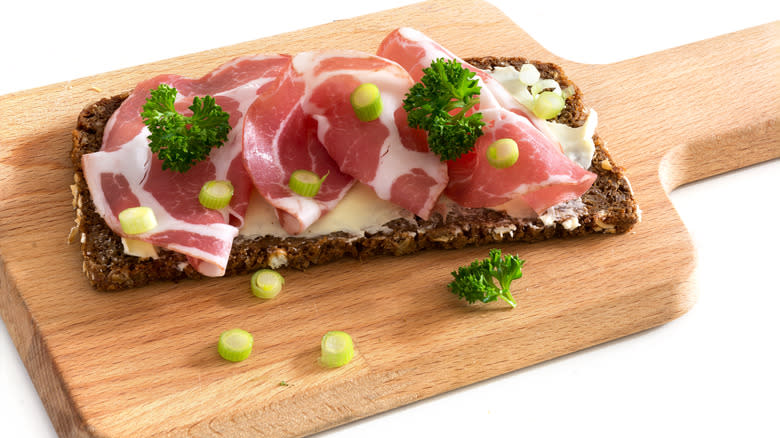
While capicola and soppressata both come from cuts of pork, they end up with slightly different tastes and textures. Since capicola is relatively unchanged before it's cured (aka it's not ground like soppressata), it ends up fatty and soft. It's also a little chewy but is typically sliced very thin so that you wind up tasting more of a tender texture. Its flavor can vary widely depending on how it was seasoned. Calabrian capicola (one of the PDO types) traditionally uses black peppercorns and vinegar, for example, while the version from Piacenza (aka the other PDO type) is flavored with salt, pepper, cloves, and cinnamon.
Capicola slices can be cooked, but they don't have to be, which means they can be used in a wide variety of dishes. You can add them to sandwiches, salads, and charcuterie boards, and they're a favorite in New York-style Italian subs along with other cold cuts and veggies like lettuce, tomato, and pickled hot cherry peppers. Or, feel free to throw them in a muffuletta sandwich alongside soppressata and mortadella. You can also add capicola slices to pastas and pizzas, wrap them around chicken breasts, or even throw them on burgers.
Soppressata Can Be Sweet, Salty, Or Spicy
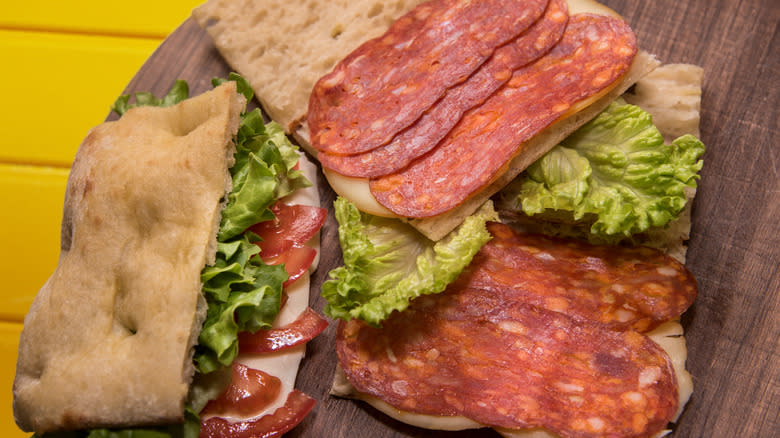
While a variety of seasonings can be used to make soppressata, you'll find three main types at grocery stores and delis: white, sweet, and spicy. Each is flavored with black, red, and hot pepper, respectively. While this sausage is a versatile one, take the type you're buying into consideration when deciding what dish to make. Unlike the buttery texture and thin slices of capicola, soppressata is denser and generally sliced thicker (think of a meat closer to salami instead). You can serve it with the penicillium casing on or off for something like a charcuterie board, although you'll want to remove it if you're incorporating the pork in a cooked dish.
Just like with capicola, soppressata works beautifully in sandwiches (such as puccia, an Italian delicacy made with pizza dough) and salads, as a pizza topping, or even diced and thrown into pasta recipes. You can also add slices to bruschetta, stir them into scrambled eggs, or roll them up and stuff them with goat cheese for a tasty appetizer. If you want to do as the Calabrians do, have a log waiting at home, ready to be pulled out, sliced, and eaten as-is when guests come over.
Read the original article on Tasting Table.

